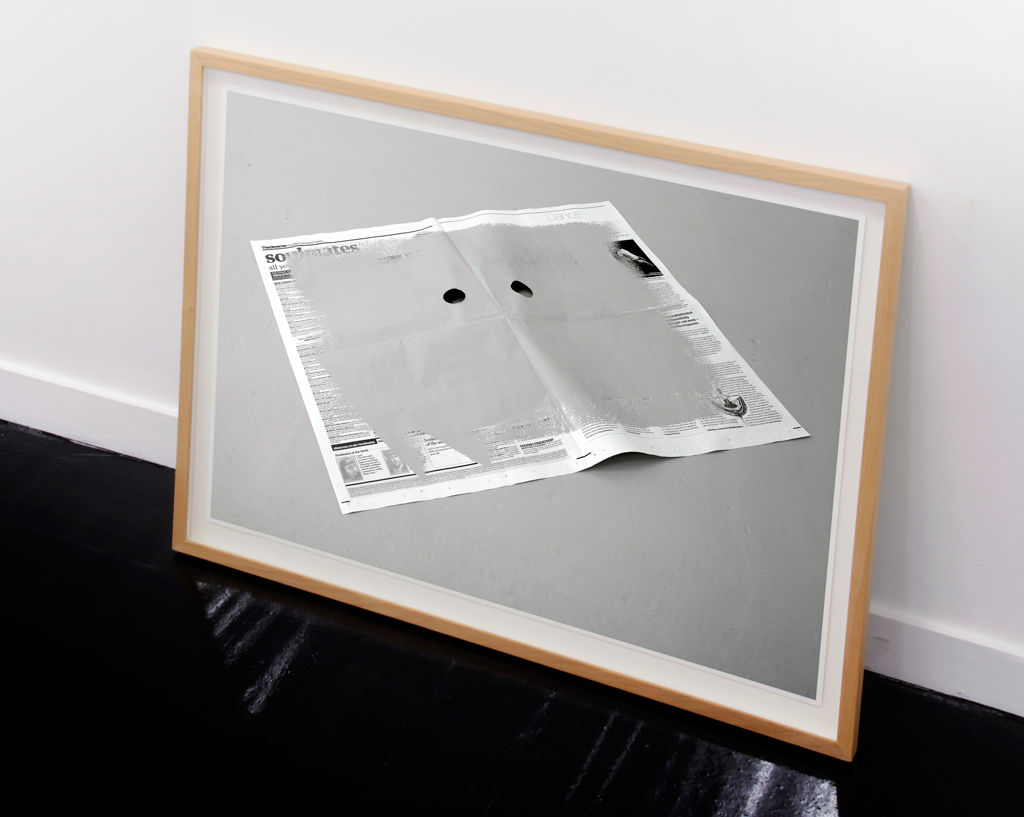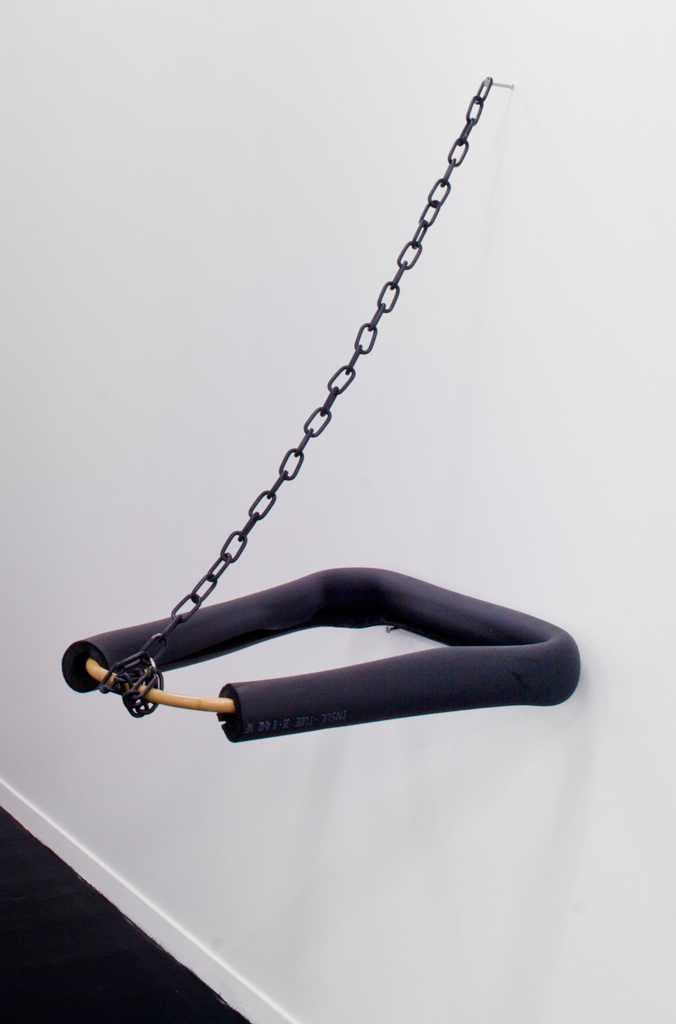

Perspex, concrete, steel, ceramic tiles, rubber

Concrete, white ceramic tiles

Digital print on paper

Bronze, 87 x 53 x 56 cm

Carved and burnt Bamboo chair, foam rubber, Perspex

Concrete, brick, wood, 87 x 76 x 60 cm

Foam rubber, bamboo, chain
Charles Mason, Hanging Together
2011, September 30th to September 5th
Plasticity of feeling and signification
Charles Mason's works often begin with a charged but mutable image. In the case of Happy or Sad, it is the image of a mouth, a clown's perhaps: which, looked at from different angles, or reflected in the accompanying Perspex, may seem happy, or sad. The image of Exit Wounds is more elusive - an image of a space hidden beneath the surface of newspaper, as if pierced by the revolver-shot from a furtive (but loving?) glance. But the image initially lacked a clear subject, though this emerged during the creative process of distortion to inform the final work. Similarly, if the image of a tear drop might have given rise to Hung up, the practical problem arises of how to match the flatness of pieces of tile with the fluid curvature of the concrete - And the solution will be determined by this formal tension. Mason's sculptures are all marked by a tension between the materiality of the objects he uses and the plasticity of the feeling they evoke. If any painting capable of moving the viewer is inevitably abstract, bringing into visibility an invisible life,1 then one might say that Mason's sculptures are the presentation in plastic form of that which seems to constitute life itself, the affective properties of things - including in particular those that are vulnerable to the propensity to play-act, cheat or deceive. All the effort of the artist would then be to give the stimuli an adequate plastic form, a struggle to maintain their precarious balance. The process might be called the poetics of the affective: the effort to reflect life in all its moving dimensions, and Mason's fragile architectures are its diagrams.
Objects and Meanings
In order to do this, Mason takes his forms and materials from a repertoire of everyday objects, thereby enrolling himself in the tradition of sculptural assemblage. His vocabulary incorporates pieces of furniture, scaffolding, piping insulation, concrete, broken ceramic tiles, and so on - the contents of a mutant house. In these works we are always initially in known territory. The artist has purposely allowed the materials their usual appearance. The unusual appearance of the finished work derives not only from the general shape of the sculptures, but from the unexpected combinations of their assembly. It is an interplay between the categories and the properties of things taking place in a space where meaning is fluid, and where the intention, in the words of the artist, is "to achieve a certain slippage, so that the new works can exist somewhere between the categories of things and the properties of things, emancipated from their superficial concrete meaning". The corporality of the pieces can be separated: the properties or tangible qualities on the one hand and, on the other, the mental categories that allow us to understand and organize that which our senses present.2 The significance of the pieces derives from the interconnections between the tangible qualities and the mental categories: this is / is not a pipe. The work of Mason, by leaving the possibility of recognizing the materials used in the construction of the piece while at the same time inserting them in unusual combinations, produces a possible displacement in meaning; we recognize the back of a chair, and cannot avoid thinking of its usual context, but at the same time the new combination in which it operates (Rocker), or its size and polished bronze surface (Crutch), prevent us from merely seeing the everyday object: this is/isn't a chair... The use of language, moreover, complicates this game of recognition, causing fluctuation in identity: Rocker (referring to heavy music, long-haired bikers in leathers, but also to the rocking chair), Crutch (turning the back of a chair into an orthopaedic support), Hung up (II) ("hanging" having the double sense of "suspended", and of a love fixation), and Stay (in the imperative, but also the act of sustaining, supporting, strengthening, both physically and morally). Mason's titles often play with double or triple meanings, so that language confronts form in such a way as to accentuate the polysemic hijacking of familiar objects.
Tragic and Domestic
We move from known things, or at least from things we recognize, to that which cannot be recognized because we lack objective categories to classify what is perceived. All the scenarios that can be projected on to the surface of the sculpture emerge from this gap between the known and the unclassifiable. The scenarios resemble old stories, domestic myths, but are so altered that we can no longer identify them as such. The effect resembles Beckett's Play where three expressionless heads, almost mere bodiless voices, play out the old tragicomedy of infidelity, but the stylization of the whole, its uneven polyphony and its very fast tempo change everything. Elements of ancient history are recognized, but have now become another thing, and the play reduces the action to the essential by erasing concrete details and thereby extends its existential scope.3 Tragedy emerges from within a humorous exterior so that life in all its seriousness suddenly appears profoundly comic. So Mason's Stay is a prayer and an order, but also a supporting device vaguely recalling a prayer stool. The resemblance to a Prie-Dieu makes the piece much more than the lament of the mournful lover. Loving you forever employs the well known catachresis of the link of love, but transposes it humorously (referencing Al Green's song which give the piece its title4 ) in a sculpture which connects nothing, and which always seems about to fall. Hung up evokes a teardrop, binding love, but, if looked at from afar and with the play on words on which the title rests in mind, suggests proximity to the trials and tribulations of life (small or large) and at the same time some distance from them. It is as if all the artists' works are tensioned between two poles: one an anchor (categories of things, sentimental attachments and tragic compassion) and the other a cutting of mooring lines (shifts in meaning, irony towards expression of feelings, towards the projected image of the self, etc.). It is as if one couldn't but oscillate between a need to find oneself, to get ones bearings, (to be someone, somewhere - to be something?) and a desire to lose oneself, to de-define oneself (to be free of any determination, at the risk of being nothing?).
Sculptural Staging
The manner in which the stories implied by these pieces are expressed and presented draw the emotions in unexpected directions. Mason's work deals with the representation of the self presented, as it were, on a theatre of inter-subjectivity. It presents us with the practical problem - how to hold on to one's sense of oneself given that identity is necessarily a fragile arrangement of social conventions, a compromise negotiated within the recesses of the psyche? Goffman has shown how daily life is entirely framed by situations that involve specific modes of presentation, and behaviour.5 The waiter is not the only one who plays at being. To be is to play. Existence is a matter of building an exterior appearance. We have to make ourselves, make ourselves a being - in the words of Sartre to give gravity to the "pour-soi" using attributes of the "en-soi", to shape the self as an object, while the subject is by definition that which cannot be defined: a nothing.6 So Mason's Rocker or Stepping Lightly evoke, suggest or imply ridiculous and touching personalities who gaze at their reflexions in a Perspex mirror in a hopeless attempt to create an image that would confirm their material substantiality, the existential weight which always escapes them. It is the same play of tensions and balances that combine to build sculptures at the edge of collapse, and yet striving to stand firm - like Pagliaccio's makeup, ready to fade under the tears he strives to contain. 7 Mason's discreet irony presents life as a stage, as a series of games played in front of a screen; the instability of the posture of his pieces reflects the uneasiness of our realization of the accuracy of his (informal) analysis.
Melancholy and Laughter
The show to which Mason invites us is tragicomic. It's the show of existence itself pervaded with humour. On their own, both melancholy and humour put us in a distanced relation to reality. Between the melancholy of Dürer, which turns its back on the world for the seclusion of the study and dark thoughts, and the wisdom of Democritus, laughing at the sight of human folly, there is a similar paradoxical proximity to reality - paradoxical in that it is possible only as a result of distance. The humour of Mason's work first recognizes the sadness, the gravity of the human situation - and then laughs. It asserts the realities of existence in all its aspects without surrendering to the temptations of resentment or the seductions of misanthropy.8
Regardless of the role which is given us - it is important to play well.
Guillaume Condello
1 See Michel Henry, Seeing the Invisible. On Kandinsky, Continuum International Publishing Group Ltd., 2009.
2 See Kant, Critique of Pure Reason, Cambridge University Press, 1999
3 S. Beckett, Play, 1963 (available in Beckett?s Complete Dramatic Works, Faber & Faber, 2006).
4 Al Green, Let?s Stay Together, 1973
5 Erving Goffman, The Presentation of Self in Everyday Life, Anchor, 1959; and also Frame Analysis, Northeastern, 1986.
6 J-P. Sartre, Being and Nothingness, Part I., Chap. 2, Washington Square Press, 1993.
7 Leoncavallo's opera, Pagliacci, shows how, for an infidelity matter, the play of marriage, and the one performed on stage, can collapse at the same time: in a crime of passion.